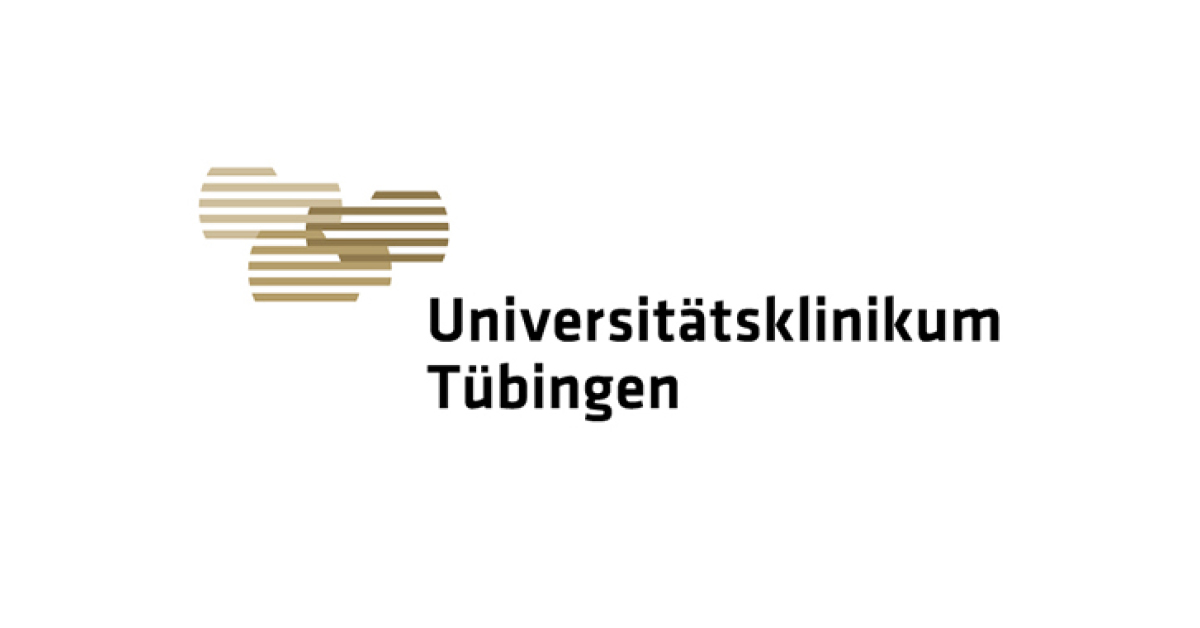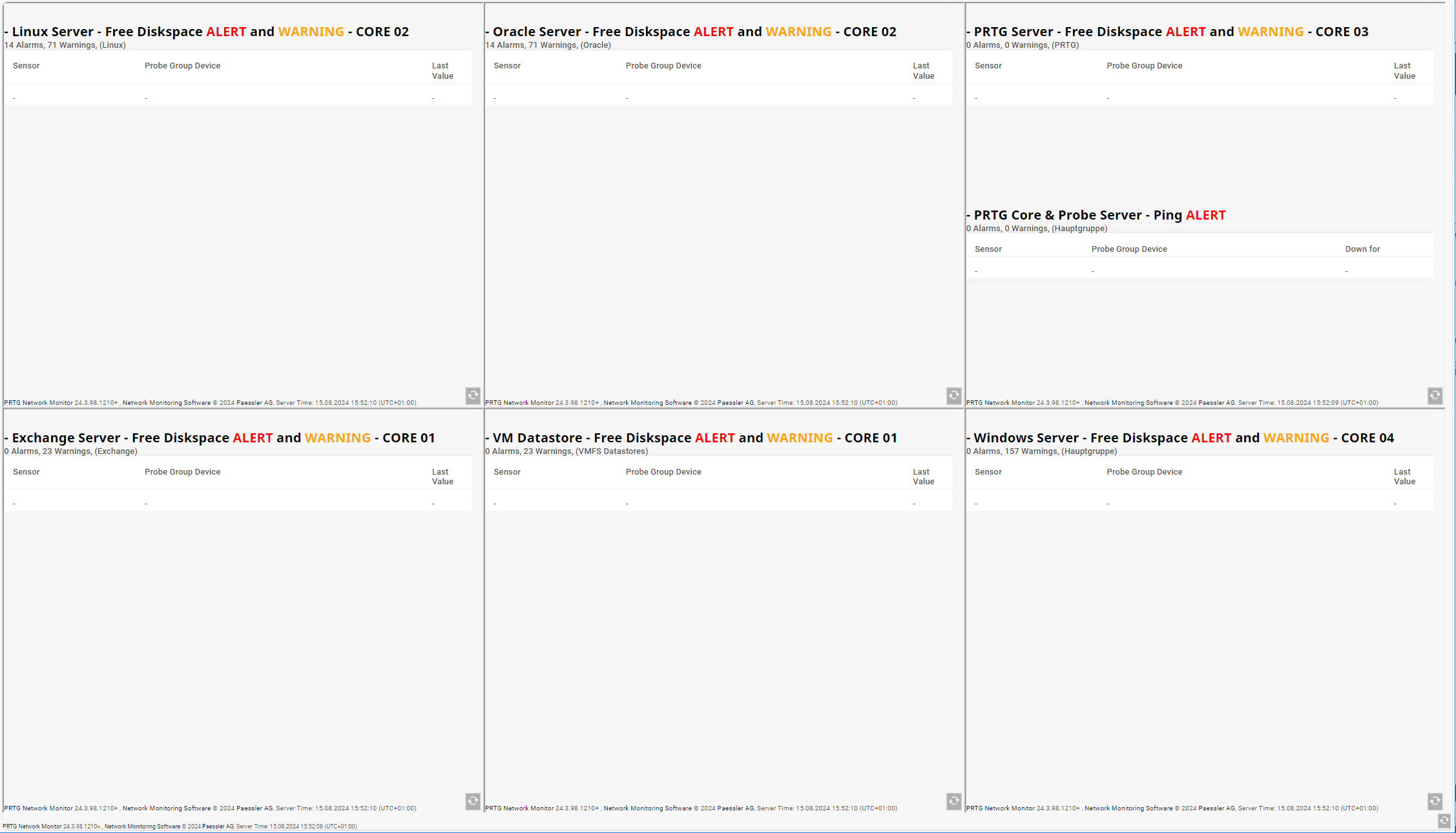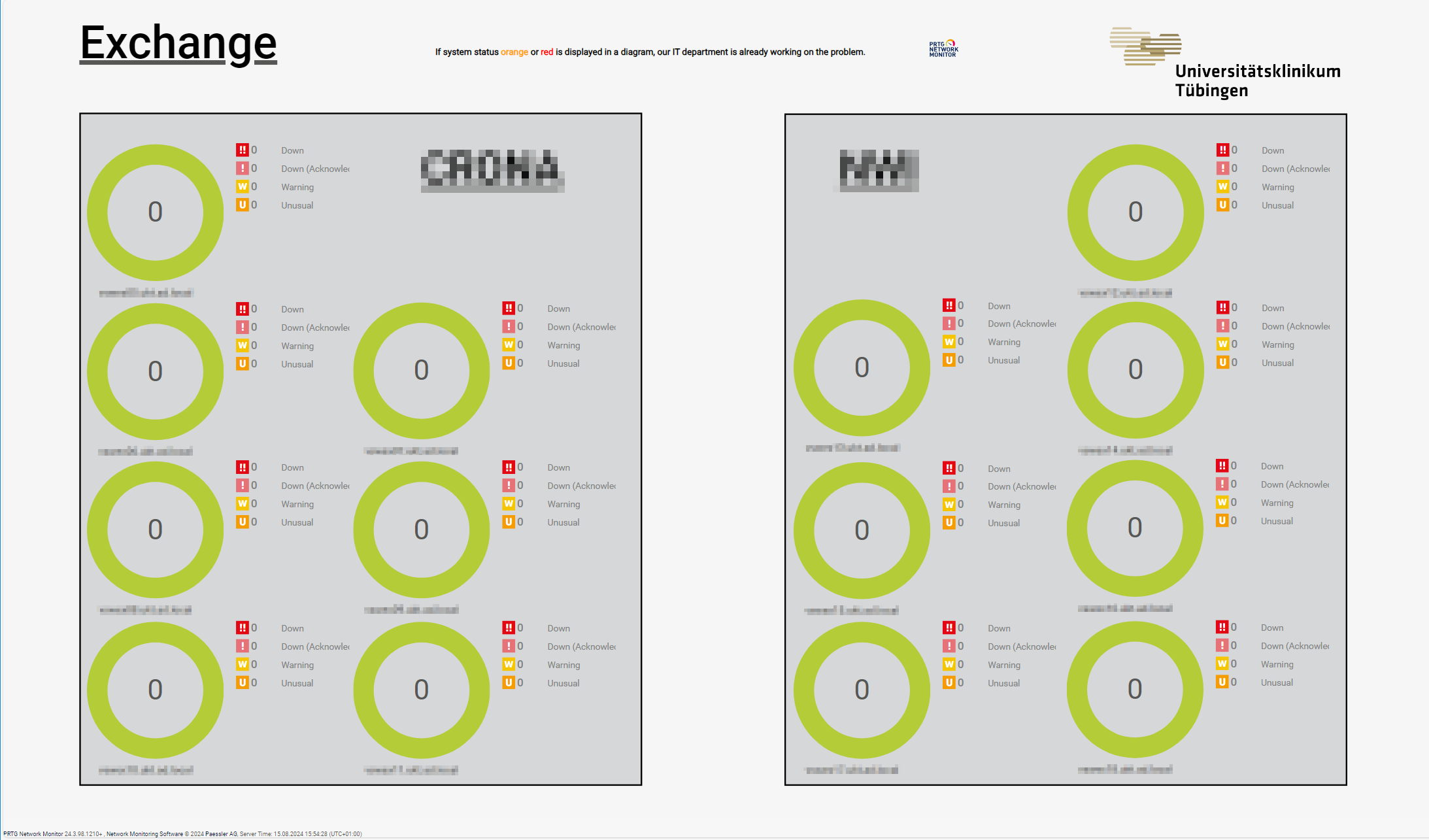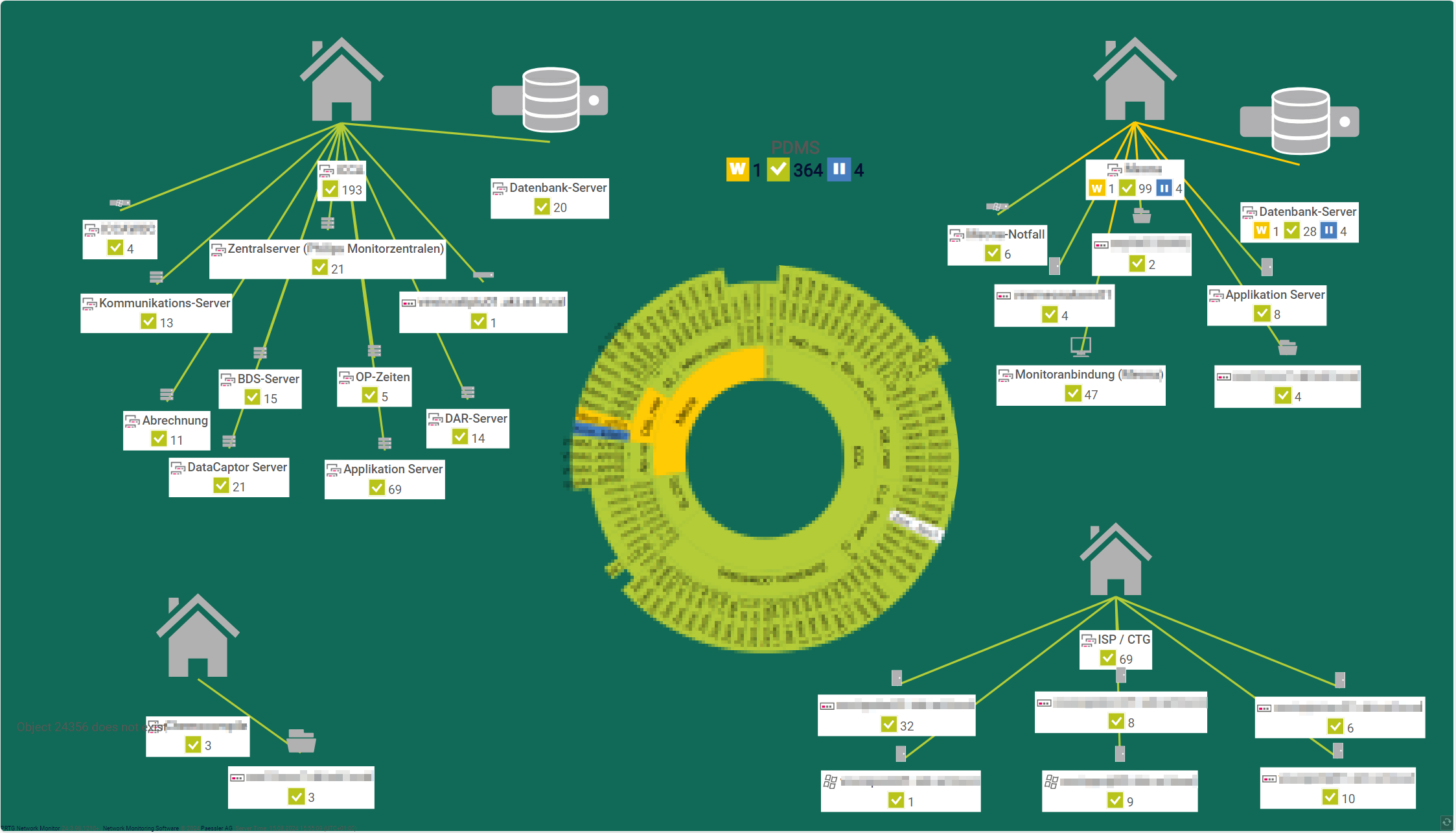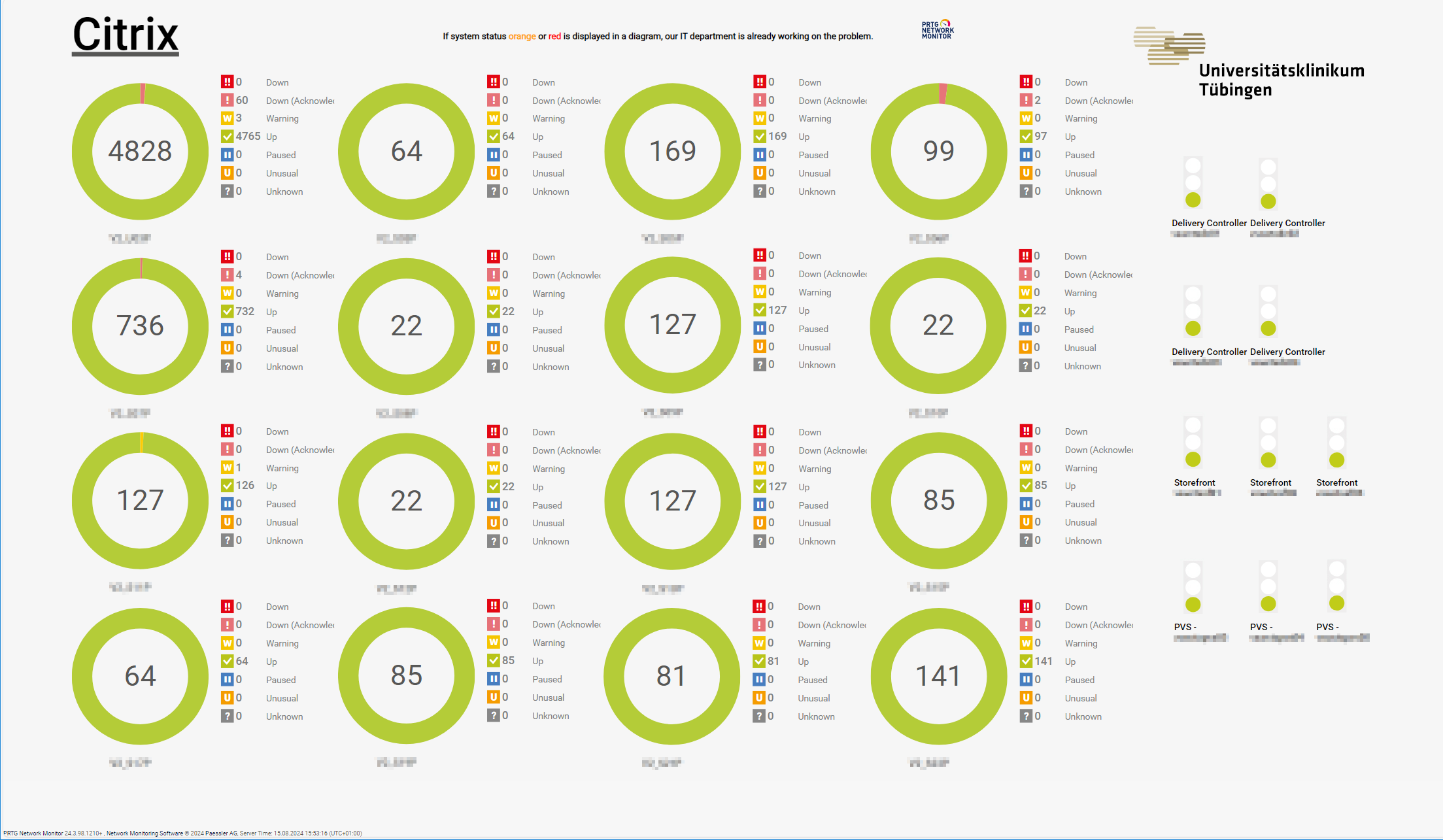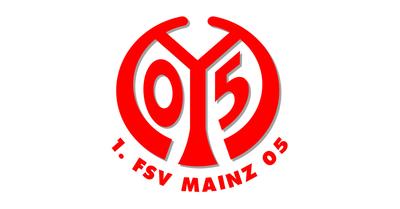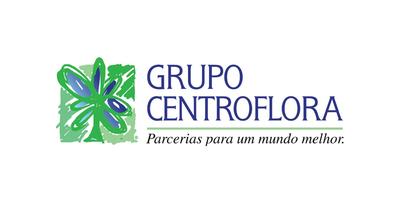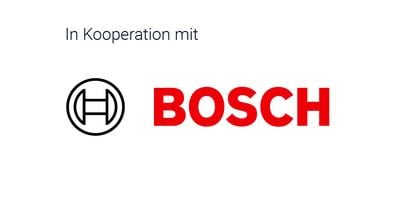Tübingen University Hospital: IT monitoring keeps everything in the clear
About Tübingen University Hospital
Tübingen University Hospital (German: “Universitätsklinikum Tübingen” or “UKT”) was founded in 1805. Today, it is one of 34 university hospitals in Germany and part of a successful network of hospitals, research centers, and teaching institutions. The UKT – with its 1,600+ beds, numerous clinics covering everything from general medicine to dentistry, schools, libraries, laboratories, skills centers, and total assets of 1.2 billion euros – is a large, complex, state-of-the-art medical center with a correspondingly large and complex IT landscape.
The UKT needed a new solution
Since IT is the single most important thing for keeping the UKT operational, it must be available around the clock. Malfunctions and failures must be detected, reported, and fixed at once. In the past, the UKT used HostMonitor and OpenNMS for this purpose. These two IT monitoring tools — a combination of open-source and proprietary software — require a great deal of expertise and experience to set up and use. In addition, at the UKT, monitoring with these tools required more technical resources than were actually available. Among other limitations, this meant that:
- only the most important systems could be monitored. Most new systems were left out of the monitoring altogether;
- additional automation measures (incorporation of new Windows servers, triggering of processes, etc.) were halted, on the one hand because the monitoring tools only offered limited options for doing so, while on the other hand there simply wasn’t enough time or resources for complex automation;
- in the event of a malfunction, alerts were sent to the on-call team, which had to troubleshoot day and night on weekdays, weekends, or holidays.
In the long term, the situation became untenable, which meant an alternative had to be found. When looking for a new solution, the UKT prioritized the following criteria:
Ease of use
Above all, the UKT did not want a solution that could only be operated by a single monitoring expert. After all, what happens if the expert is not available? What’s more, specialists would be required to spend an inordinate amount of time training an expert on using the software on the respective systems and devices, instead of simply setting up the monitoring themselves. The software therefore needed to be operable without extensive programming knowledge or experience. Its installation and configuration also needed to be as straightforward as possible.
Process mapping and automation
The UKT wanted to combine multiple components and systems in processes to create automation possibilities, thereby making it easier to locate and classify malfunctions, and in the best case scenario, fix them automatically with a reboot or script.
Ability to adapt to requirements in the future
First of all, the new monitoring system was to be simpler and more powerful than the existing solution. Ideally, however, it would also be able to handle expansions in the future. Above all, the UKT is a state-of-the-art medical center. In addition to IT, it also deploys numerous medical devices and systems. By incorporating these devices and systems into a centralized monitoring environment with IT, the UKT could locate errors faster and immediately get down to troubleshooting. At the same time, the new solution had to have methods for monitoring medical environments.
After comprehensively testing a variety of tools, the UKT decided to go with Paessler PRTG. Among other things, the widespread use of PRTG was an important factor in the decision, especially since the UKT and some of its employees had already had some experience with the tool.
“Many employees in our departments have specific ideas about how their devices and services should be monitored. Thanks to the intuitive design and outstanding usability of PRTG, they can set up their own monitoring themselves without much training.”
Torsten Schoen, PRTG Service Owner at Tübingen University Hospital
An overview of all IT components: Permissions for relieving the workload
Today, the UKT monitors its IT environment with PRTG, using more than 18,000 measuring points, or so-called PRTG sensors. As the service owner, Torsten Schoen is responsible for monitoring the core systems, i.e., the hardware, the servers, and the most important applications. These include the VMware environment, NetApp, SAN storage, the Windows and Linux operating systems, Citrix, SQL and Oracle databases (including the Oracle hypervisor environment), SAP integration, and much more — such as certain medical applications that serve as important clinical processes.
What’s more, experts in the individual departments have limited access to PRTG: they can monitor their own services, devices, and applications with PRTG, but not the UKT’s core components. Schoen explains:
“Many employees in our departments have specific ideas about how their devices and services should be monitored. Thanks to the intuitive design and outstanding usability of PRTG, they can set up their own monitoring themselves without much training. However, these employees are not as familiar with the network and the underlying servers. By only granting them access to the systems within their area of expertise, they can configure their monitoring environment in PRTG without being able to access the core components. In other words, they cannot inadvertently access the monitoring in areas outside their area of expertise, and cause problems (for example) by pausing the monitoring of a server or deleting sensors. In addition, these centralized and decentralized monitoring environments save us a lot of time and energy that we in the IT department would otherwise have to invest in the monitoring of the individual departments.”
Schoen uses PRTG probes (“polling engines” that retrieve monitoring data) to manage employee permissions. In the event of a malfunction, the on-call team is alerted along with the experts from the respective department. These alerts and notifications — as well as the triggering of automated actions — are controlled in PRTG by way of tags and libraries.
“Thanks to the business process sensors and many automation options in PRTG, we’ve managed to significantly reduce the workload of our on-call teams without affecting the reliability of our systems.”
Torsten Schoen, PRTG Service Owner at Tübingen University Hospital
Automation and relief for the on-call team
In the past, the on-call team was always alerted when a malfunction occurred outside normal working hours. This meant that employees sometimes had to get up at 3 a.m. on a Sunday morning just to boot a server. With PRTG, Schoen can now combine several components in a single process and therefore also display redundancies. For example, if one of three redundant servers fails, an email (at the most) is sent to the respective team and the on-call team is not disturbed. And even when failures occur in systems that are not redundant, Schoen uses PRTG to relieve the on-call team by deploying automated processes that can (for example) restart services, boot a server, or pause a group of sensors.
Schoen cites the spooler service of his print servers as an example. In the past, if a service hanged or crashed, the on-call team was alerted immediately — no matter the time of day or night. Today, PRTG reboots the print server first, and only triggers an alert if the problem is not resolved within a set period of time.
Schoen discusses the advantages of PRTG:
“Thanks to the business process sensors and many automation options in PRTG, we’ve managed to significantly reduce the workload of our on-call teams without affecting the reliability of our systems. Having PRTG automatically reboot a system outside of official working hours is always faster than notifying on-call staff, who always need a bit of time before they can intervene. Our hospital is a 24/7 service, and in extreme cases, lives depend on smoothly functioning systems. The quicker we troubleshoot, the more reliable our systems become and the better the care we can offer our patients.”
Everyday monitoring
With PRTG, the UKT IT team is not just relieved of the most obvious issues. With a little creativity, the software can also help with more minor, everyday processes:
“In addition to the usual sensor statuses (red, yellow, and green — which don’t really interest anyone), PRTG also displays paused sensors in blue. More often than not, employees pause sensors in bulk for maintenance purposes and then forget to reactivate them after the maintenance is complete. With PRTG, we simply monitor the number of paused sensors and receive a notification as soon as this number reaches a value set previously by our team. We then check the information, and if necessary, inform the respective employee. This helps us make sure our monitoring is always up and running as required.”
Schoen also appreciates PRTG for the software’s “maps,” or customized and easy-to-create dashboards that the IT manager displays on large monitors for his teams:
“Emails are easy to overlook; besides, we don’t want to alert our teams about every little thing via email, text message, or push notification. PRTG maps have proven to be an extremely useful and effective tool: if a sensor on the office monitor suddenly turns red, it’s surprisingly easy to see and the respective team member can quickly take care of the problem.”
An eye on the future
PRTG also appealed to the UKT thanks to its adaptability, which makes it the perfect tool for the future. The first step involved monitoring the IT and its associated medical systems. At the same time, a hospital is not a static system. IT is continually expanding and becoming more and more important. Medical environments, too, are increasingly becoming digitized and integrated with IT. For the UKT, it was therefore important to switch to a solution that could serve as a stand-alone monitoring system in the long term while also meeting the challenges of the future. Several aspects had to be taken into consideration:
- Scalability: The current PRTG installation can operate with up to 18,000 sensors. The UKT opted for a PRTG Enterprise Monitor license that allows it to install any number of additional PRTG servers, which means it must simply increase the number of its sensors.
- Decentralization: In the future, the UKT plans to increase the segmentation and decentralization of its IT infrastructure and network. Thanks to the PRTG Enterprise Monitor license and the software’s remote probes, PRTG can provide all the monitoring features that are needed to support these measures.
- Incorporation of non-IT components: In the long term, Tübingen University Hospital also plans to extend its monitoring to areas beyond IT. These areas include both medical devices and systems, as well as (for example) building technology in the data center. PRTG is fully equipped to handle this additional monitoring thanks to its native support of methods such as DICOM and HL7 in the medical field, as well as Modbus and MQTT in building technology.
- German Hospital Future Act: Last but not least, comprehensive IT monitoring also plays an important role in meeting the requirements of the German Hospital Future Act by ensuring and improving the security and reliability of the IT environment.
Conclusion and outlook
Schoen also sees great potential for expanding the UKT’s PRTG monitoring to other medical departments:
“Most of the time, the medical teams at the hospital don’t even know how PRTG monitoring can benefit their department. Thanks to the software’s compatibility with DICOM and HL7, we can monitor medical environments almost entirely with PRTG. Communications servers can also be connected to PRTG via predefined interfaces. By implementing comprehensive monitoring that covers both IT and medical technology systems, we can conduct much more efficient error analysis and promptly locate and fix malfunctions before they lead to serious problems.”
Get to know more happy PRTG customers
Customer success story 1. FSV Mainz05 & PRTG
The IT team of 1. FSV Mainz05 monitors its IT and the entire stadium technology with PRTG so that everything runs penalty free. ➤ Read the complete customer success story now!
Customer success story Centroflora Group & PRTG
With PRTG, Centroflora gets a holistic view of their industrial environment, particularly processes based on Siemens PLCs and the power supply. ➤ Read the customer success story now!
Customer success story Bosch Energy and Building Solutions & PRTG
Bosch Energy and Building Solutions integrates its entire IT monitoring into its building management system via PRTG and OPC UA. ➤ Read the complete customer success story now!
We are happy to help!
Do you need more information, a live demo of PRTG Enterprise Monitor, or a formal quote?
Leave us your contact details and we'll reach out to discuss your individual setup.
